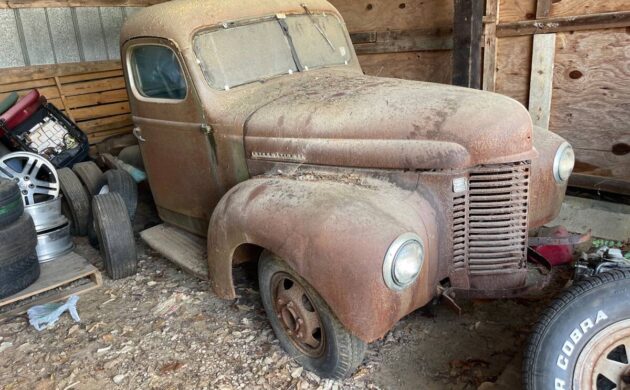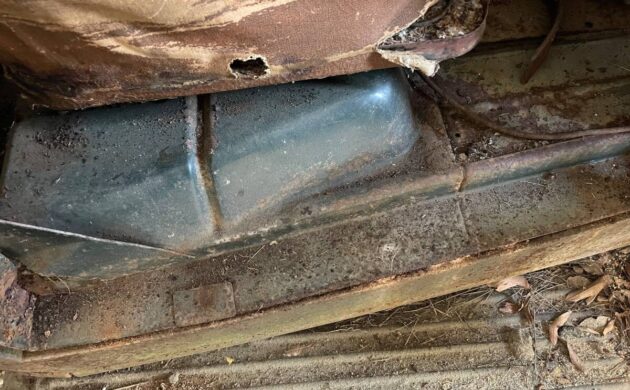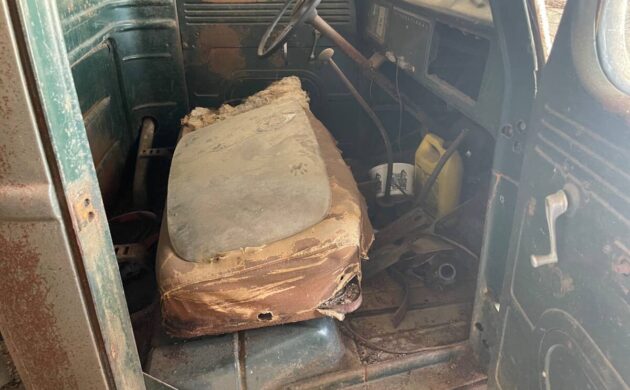In 1940 International Harvester introduced the K series of trucks, which updated the styling of the C series. The K’s had flowing lines, a radiator incorporated into the frontal structure, and headlights embedded into the fenders. The K-line offered sizes to suit every load, from the K1 at 1/2 ton to the K14. Here on craigslist is a 1941 International Harvester K3 1-ton truck for sale at $3,500 OBO. The seller will entertain a trade as well. The truck is in a barn in Winston-Salem, North Carolina, and is sold on a bill of sale only. We have Chuck Foster to thank for this tip! The K-line offered pop-out windows as an option – hard to tell if this one offers that amenity. A chrome bumper was also an option; this one includes the empty brackets.
Restored 1940s K series trucks command prices in the mid-teens; a similar fully restored model received a high bid of $16,500 at Mecum in 2020. This K3 has been sitting for years and does not run. Some parts missing from the cab appear to be piled behind the truck; there is no sign of the bed. This truck was originally green but has gone thoroughly to rust. That said, these stout beasts can rust a lot before breaking apart. This sill doesn’t look terrible.
The motors were IH’s Green Diamond in-line flathead sixes, paired with a single Zenith carburetor. The sixes came in a few flavors – the 175 cu in, the 214, and the 233. The most common engine appears to be the 214 cu in, paired with a three-speed manual transmission. Horsepower was about 82, making it underpowered relative to its competition. That said, these trucks outsold Dodge and GMC and were used extensively as fleet vehicles by delivery companies, utilities, and all manner of businesses. As shown here, the hood opens alligator-style, a departure from the preceding C-line that opened butterfly-style.
The interior, along with everything else, needs work. I think I see the back to the bench seat in the pile of parts referenced earlier. Still, this truck is going to absorb a lot of work before she looks like this. What do you think, is it worth the effort?






Michelle found my weakness, great writeup. If I may add, the K model came after the ’37-’40 “D” series, a bit more “Art Deco” than the C series, but the K model, as mentioned, was a radical departure from previous styling. The crank on the dash indicates a crank out windshield. I think they all had that. The KB that followed, I believe was the last year for that feature. The K3 was kind of an oddball. Being a 1 ton, many were overloaded, and many found out, a heavier model was needed. There was no K9 ( being a dog) and no K13 for obvious reasons. This will undoubtedly become a hotrod, and that’s okay. As is, it’s kind of useless. They are still out there, apparently.
Great! You never know what’s going to resonate…. in the research for this article I found that someone had restored a K4, which turns out to be a 1 1/4 ton, a real oddball.
Thanks for the trucks, Michelle. Our resident IH expert, among other things, is Geomechs. He’s forgotten more than I know, and any IH questions, he’ll be sure to answer,,correctly. I’m just an internet “regurgitator” these days, but Geomechs has old IH grease under his fingernails, I’d bet!
Hello, Howard and Michelle. Yes, the K-line followed the D-line but a lot of the D hung on. The D-series had a larger cab and when it gave way to the K-series halfway through 1940 the newer, more compact cab took over for the K-1 thru the K-5. However, the K-6 thru the K-14 continued using the D-cab. I don’t know why, other than someone must’ve thought the drivers of the bigger trucks were bigger as well. More likely because of the larger front fenders for the K-6 and up. Another intersting tidbit of information: the K-1 thru the K-5 panel trucks had the same front sheet metal as the K-1 thru K-5 regular cab. But–from the cowl back IH continued to use the D-body which was slightly altered to accomodate the newer K-series rear fenders.
I’m sure this truck would be running a 4-spd. Crashbox. It would be a Warner T-9, the same super whiner that was used by Ford, Dodge, Studebaker and Diamond T, just to mention a few. Straight-cut gears combined with double-clutching could separate the devout from the weekend joy-riders.
This looks like a dually so it likely had a stakebed but could also have sported a pickup box with fenders that accomodated the dual wheels.
Another interesting feature for this truck was that it has the hubs to accomodate hubcaps on those Budd wheels. That was a feature that was used regularly by Binder and Studebaker and although I heard it was available on Dodge as well, I never saw hubcaps with Budds on a Dodge.
Now this truck and me. Of course I would want to take this home and restore it. Probably build a stake bed or see if I could find a box and fenders. Hubcaps would be a challenge as repros are not available for the Budd wheels These old tonners were good trucks and deserve to be restored, and used, and driven, albeit a lot more slowly…
Friend turned a 1/2 ton into one of the best looking and running restomods I’ve ever seen. The bed notwithstanding, the art deco cab and front end really make these guys shine.
Undervalued and just starring to be appreciated, these Internationals are very bullet proof. Last year I picked up a 1940 D2 half ton pickup. Some of the parts that International stopped using on the K series were just getting implemented on other truck lines in the late 40’s. I source many parts that way. I love my D2. It’s like a Diamond Reo Mini me and gets a fantastic response wherever I take it.
That D2 is a true gem. I spend many hours a week chasing down parts for old international trucks. It’s a wonderful feeling being able to find that part that someone so desperately needs but it’s also crushing to see the trail dry up. I have a ‘38 D-2 that is in waiting for its restoration. It seems like I spend all my time helping others and when I get home I’m played right out. Of course, recovering from an injury doesn’t help either…
Hope uou can get your D2 on the road soon. My proudest find has been four crusty but solid original artillery wheels, which I have now derusted, filler primed, sanded, etc. I got some spring steel from Speedway and made new hub cap clips for the ones broken off. I sprang for the new repro triple diamond hubcaps and resized the clip angles on the wheels to fit them. Still a ways away from mounting tires and getting them on. I won’t bore you with braking, fuel, electrical systems, on and on…
I’m sure we could get into one heck of a conflab over the D-2s. You made a major score finding those artillery wheels; I’ve found two so far and one of those is pretty much a write-off. Those clips are unobtainium and the only way is to make them.
I have a client in TX whose customer brought him a ’40 D-2. Nice shiny “recent” restoration. Well, I think the major contributors were Krylon and Tremclad. He’s had to go through the truck from end to end to get it working. The rear hubcaps were “EPOXIED” into place so he’s had to work with the wheels as well. Every time my client phones me he tells me that his backside is another couple of bites smaller. Sometimes I think you’re better off getting one in the rough than one that has been “restored.” Here’s a pic of my boss’s D-15. He bought it restored but lucked out completely as it was fanatical…
Same color scheme as mine! Do you ever hang out at the Facebook page for D series IH’s. I’ve found some unobtaniums there and folks are friendly.
Oh, yes. I belong to a number of FB pages. There’s quite an enthusiastic crowd of Binder fans. I’ve got a lot of clients from there; and I’ve sent a lot of clients there. And if I can’t help them immediately, I can always share a good story…
Ashes to Ashes dust to dust pop cans
Hi Geomechs! I am a IHC truck, tractor and stationary engines collector in Lima, Perú. Have a few models from 1920 chain driven trucks, up to 1965 Scout. I am looking for a Clutch housing for a 1946 L-110 with a four speed transmission, the front SS grill trim bars and front parking lights with glass lenses. Also, for a 1963 Travelall Station Wagon. I need a set of SS wiper blade arms with blades and the side quarter a panel “Travelall” scripts. Kindly provide me with any possible contacts you might have, where I could find those parts. My grandfather was the exclusive IHC dealer in Perú from 1920 thru 1958 with 23 agencies nationwide. Full nostalgia about IHC, I crawled at his shop since very young! Due to the critical local political situation The collection could be offered for sale if you know of anyone one interested.
Hi Pedro. Can you send me some pictures? Contact me at [email protected]. Let’s see what you need and we’ll see if we can point you in the right direction…
So you seem to know these trucks well. A friend of mine tells me there’s a few sitting on his grandparents property. I’m going to go check them out and take some pics in the near future. I’m wondering what the budd hubcaps look like and also any other rare parts I should look for if the trucks are too fast gone? Thanks. I know one is a 1938 and that one was used to plow snow up until 2 years ago. I’m in Northern Wisconsin. You can email me at super fly chef guy at outlook. Com